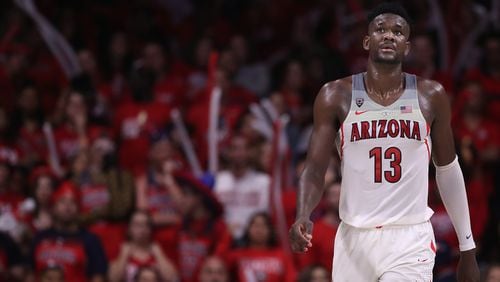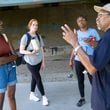The Hawks are on track to have as many as three first-round picks in the 2018 draft. Their own pick is almost certain to be in the lottery. The Hawks also own a pick via the Rockets and will have a third pick if the Timberwolves qualify for the playoffs.
This is the sixth of my occasional reports on prospects expected to be selected in the first round of the draft.
Previous entries
DeAndre Ayton
College: Arizona
Hometown: Nassau, Bahamas
Class: Freshman
Height/weight: 7-foot, 243 (measured)
Age: 19 (July 23,1998)
ESPN draft projection: 2nd
(This is the first entry from my three-campus college tour last week. Look for a report on Oklahoma’s Trae Young tomorrow. My plans to see Mohamed Bamba at Texas on Saturday fell through when he was ruled out with an injury but I talked to coach Shaka Smart about Bamba and took a closer look at another one of his NBA prospects, Kerwin Roach II.)
TUCSON, Ariz. -- Before venturing to see Ayton, who announced his intention to declare for the draft, I'd watched all the top U.S.-based NBA prospects play games on television (except for Michael Porter, who just returned from injury). I also saw Marvin Bagley II and Wendell Carter Jr. live in New York. My take was that Ayton is the best prospect among them all because of his physical talent and skills, and nothing I saw from him during Arizona's victory over Stanford on Thursday changes that opinion.
However, because I was already sold on Ayton as the top prospect (not including Luka Doncic, who I haven’t watched play yet) I went to the Stanford game with a skeptical eye. I was looking for signs of what all reports indicate is (relatively speaking) his main weakness: lack of “feel” for the game, which mostly shows up on defense.
Those concerns are real.
Ayton was passive on defense for much of the Stanford game, especially when the Wildcats played a zone scheme. That alignment theoretically should have allowed Ayton to patrol the paint as a help defender but he wasn’t aggressive doing so. There were a handful of plays in which Ayton easily could have slid over to help on drivers with his massive wingspan (7-foot-5.5) but instead watched the play while staying pinned behind a Stanford big (usually Reid Travis, a stout 6-9 forward).
Ayton hasn't been an elite shot blocker in college despite his substantial physical advantage over his opponents. According to Kenpom.com, Ayton's block percentage of 7.0 in 18 Pac-12 games ranks just fifth in the conference (and that's an improvement from his blocks production in non-conference games). Back in December, when Ayton's block percentage was just 4.3, The Ringer pointed out that it ranked tied for 15th among the 17 bigs drafted in the top 10 since 2010. Ayton's current block rate of 6.1 still only ranks 12th among that group.
There's more to defending the rim than blocking shots, of course. According to Synergy Sports, Ayton rates in the 86th percentile in points per possession allowed as a defender around the basket on non-post ups (62 total plays). But those stats don't include the plays when Ayton fails to challenge shots in his area, and he rates in just the 64th percentile in PPP allowed as a post-up defender (47 total plays).
I saw some reasons why Ayton doesn’t dominate as a paint defender like he could. Ayton’s apparent lack of instincts shows up in his defense around the basket, just as it does with his inattentive help defense.
Travis had success keeping Ayton off balance with pump fakes, a weakness for Ayton that you can see in other clips. Ayton seems to struggle with anticipating his opponents’ moves and timing his challenges. Because of his length and leaping ability, Ayton could wait for his defender to commit to a shot before jumping but he doesn’t seem to have the feel or confidence to do so.
The team that selects Ayton in the draft will have to determine why he hasn’t reached his defensive potential. If it’s about effort, can NBA coaches and professional responsibility motivate Ayton? If it’s about instincts and feel, can those things even be improved and, if they can, by how much?
My view — which doesn’t come with the pressure of my job being on the line if I’m wrong — is that Ayton is worth the chance. If he improves significantly in those areas Ayton can be the kind of franchise-changing player worthy of the No. 1 overall selection because of his rare physical abilities and offensive skills for a player his size.
Ayton's offensive rating is second-best in NCAA Division I among high-usage players, according to Kenpom.com. He's produced 23.9 points per 40 minutes with a 65.7 true shooting percentage. Ayton is powerful but nimble around the basket with excellent hands, footwork and touch. Those attributes allow Ayton to score with smooth drop-step-and-spin moves around the basket. (Pre-college reports indicated that he didn't have that ability then so there's been improvement.) Ayton's turnover rate (13.0) is very low for a big and he's an outstanding finisher: 97th percentile on non-post up PPP around the basket with a 73.7 percent field-goal percentage, according to Synergy.
Ayton can run the floor well (though he appeared fatigued at times against Stanford). His offensive and defensive rebounding rates are off the charts, ranking 53rd and 14th in NCAA Division I, according to KenPom.com. Those numbers are especially impressive because Ayton plays most of his minutes alongside another good rebounder, 7-footer Dusan Ristic.
Ayton figures to contribute immediately in the NBA as an effective paint scorer, rim runner and rebounder. Ayton has attempted just 32 3-point shots (11 makes) for Arizona but he has the potential to be a 3-point shooter in the NBA.
Ayton’s solid 75 percent free-throw shooting is a good sign because that stat correlates with NBA 3-point shooting. He has a smooth, confident jump shot with a high release point that he doesn’t hesitate to launch off the catch or as a turnaround jumper. Synergy credits Ayton with a 49.2 effective field-goal percentage on 64 catch-and-shoot jump shots, including 56.7 eFG% on 30 unguarded chances.
Ayton showed good passing ability against Stanford. On two occasions he drew double teams and made nice passes to cutters for scores. Another time he dropped a bounce pass to teammate Keanu Pinder for a dunk.
Ayton’s offensive game is well-rounded but there are some weaknesses.
Mirroring Ayton’s passive approach to help defense is his lackluster screening. Several times I saw him barely try to set a high screen for teammates before half-heartedly dropping back down into the paint. Other times he remained stationary as a screener when a slight adjustment one way or the other would have freed the ball-handler. This is another area in which NBA teams must decide if the issue is effort or instincts, and whether it can be improved significantly.
Ayton's assist percentage (9.9) is pretty good for a big man and, as mentioned earlier, he made some good passes out of double teams against Stanford. But in his Jan. 17 review of Ayton, Ben Falk of Cleaning the Glass concluded that Ayton is "far from an intuitive passer" who misses open teammates, makes poor decisions and telegraphs passes.
Ayton has holes in his game, especially his lack of feel, and that may be the reason he’s not the No. 1 overall pick in the draft. But no prospect is perfect, and Ayton’s massive production and potential as a 19-year old is why he projects to be among the top three picks.
Ayton's relative lack of instincts could be explained in part by his late start in basketball and very late introduction to high-level competition. A positive spin on those circumstances is that Ayton hasn't yet tapped into his potential like a prospect who has seen both for most of their lives.
“He’s just grown in every facet of the game but he’s also become more mature, more responsible,” Arizona coach Sean Miller said after the Stanford game. “Things that happen in college where you learn how to manage your time, how to do things on and off the court, play with other talented players. There’s really nothing that he does here in early March that he’s not better at.
“His free throws, sometimes he will rush it, because he’s a very good free-throw shooter. Other than that, I think that he’s moving in (an upward) direction and he’s not going to stop.”
About the Author







